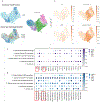Epigenetic Regulation of Profibrotic Macrophages in Systemic Sclerosis-Associated Interstitial Lung Disease
- PMID: 35849803
- PMCID: PMC9771864
- DOI: 10.1002/art.42286
Epigenetic Regulation of Profibrotic Macrophages in Systemic Sclerosis-Associated Interstitial Lung Disease
Abstract
Objective: Systemic sclerosis-associated interstitial lung disease (SSc-ILD) is the leading cause of death in patients with SSc with unclear pathogenesis and limited treatment options. Evidence strongly supports an important role for profibrotic secreted phosphoprotein 1 (SPP1)-expressing macrophages in SSc-ILD. This study was undertaken to define the transcriptome and chromatin structural changes of SPP1 SSc-ILD macrophages in order to better understand their role in promoting fibrosis and to identify transcription factors associated with open chromatin driving their altered phenotype.
Methods: We performed single-cell RNA sequencing (scRNA-Seq) on 11 explanted SSc-ILD and healthy control lung samples, as well as single-cell assay for transposase-accessible chromatin sequencing on 5 lung samples to define altered chromatin accessibility of SPP1 macrophages. We predicted transcription factors regulating SPP1 macrophages using single-cell regulatory network inference and clustering (SCENIC) and determined transcription factor binding sites associated with global alterations in SPP1 chromatin accessibility using Signac/Seurat.
Results: We identified distinct macrophage subpopulations using scRNA-Seq analysis in healthy and SSc-ILD lungs and assessed gene expression changes during the change of healthy control macrophages into SPP1 macrophages. Analysis of open chromatin validated SCENIC predictions, indicating that microphthalmia-associated transcription factor, transcription factor EB, activating transcription factor 6, sterol regulatory element binding transcription factor 1, basic helix-loop-helix family member E40, Kruppel-like factor 6, ETS variant transcription factor 5, and/or members of the activator protein 1 family of transcription factors regulate SPP1 macrophage differentiation.
Conclusion: Our findings shed light on the underlying changes in chromatin structure and transcription factor regulation of profibrotic SPP1 macrophages in SSc-ILD. Similar alterations in SPP1 macrophages may underpin fibrosis in other organs involved in SSc and point to novel targets for the treatment of SSc-ILD, specifically targeting profibrotic macrophages.
© 2022 American College of Rheumatology.
Conflict of interest statement
Conflicts of interest R.L. served as a consultant for Bristol Myers Squibb, Formation, Sanofi, Biocon, Boehringer-Mannheim, Boehringer-Ingleheim, Merck and Genentech/Roche, and holds or recently had research grants from Corbus, Formation, Elpidera, Regeneron, Pfizer and Kiniksa.
Figures





References
-
- Abraham DJ, Varga J. Scleroderma: from cell and molecular mechanisms to disease models. Trends Immunol. 2005;26(11):587–95. - PubMed
-
- Steele R, Hudson M, Lo E, Baron M, Canadian Scleroderma Research G. Clinical decision rule to predict the presence of interstitial lung disease in systemic sclerosis. Arthritis Care Res (Hoboken). 2012;64(4):519–24. - PubMed
-
- Distler O, Highland KB, Gahlemann M, Azuma A, Fischer A, Mayes MD, et al. Nintedanib for Systemic Sclerosis-Associated Interstitial Lung Disease. N Engl J Med. 2019;380(26):2518–28. - PubMed
-
- Khanna D, Lin CJF, Furst DE, Goldin J, Kim G, Kuwana M, et al. Tocilizumab in systemic sclerosis: a randomised, double-blind, placebo-controlled, phase 3 trial. Lancet Respir Med. 2020;8(10):963–74. - PubMed
Publication types
MeSH terms
Substances
Grants and funding
LinkOut - more resources
Full Text Sources
Medical
Molecular Biology Databases
Research Materials
Miscellaneous

